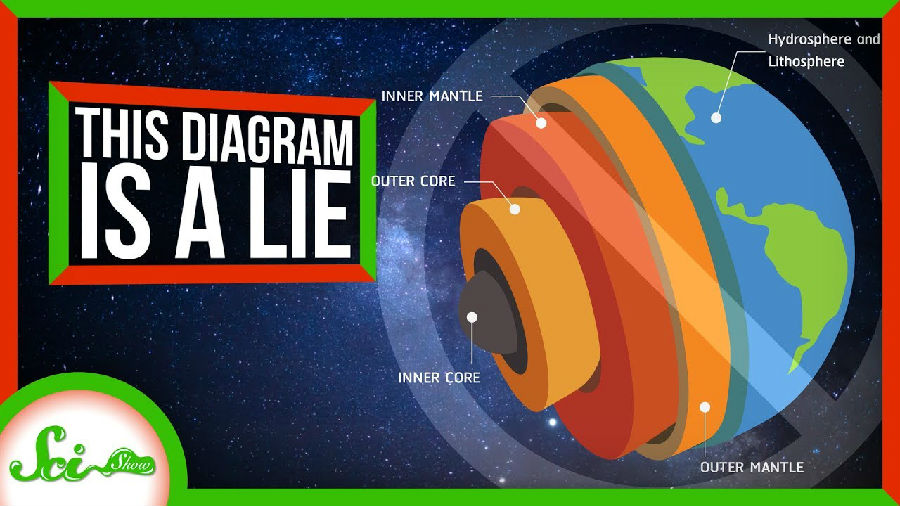Thanks to Brilliant for supporting this episode of SciShow.
感谢Brilliant对本期节目的支持。
Go to brilliant.org/SciShow to grab a gift subscription to help your loved ones spark a lifelong love of learning.
登录brilliant.org/SciShow订阅一份礼物,帮助你爱的人激发对终身学习的热爱。
When you learned about the Earth's interior in elementary school,
小学学习地球内部结构的时候,
you were probably shown a diagram that looked like a perfect layer cake.
大家或许会看到一幅看起来像一个完美的夹心蛋糕的图。
You had the thin crust, the thicker section of the mantle, the outer core, and the inner core,
地壳很薄,地幔较厚,还有外核和内芯
and everything was smooth and even: perfect nested spheres.
整体看起来光滑平坦:完美的嵌入球体。
I hate to burst your bubble, but we've known for a long time that that diagram just isn't true.
我不想戳破你的幻想,但是很长时间以来,我们都知道那个图是错的。
At least, when it comes to the mantle. In reality, the Earth's mantle is far from a perfect, smooth layer.
至少地幔是错的。事实上,地球的地幔远非一个完美、平滑的层。
Instead, it has some gigantic blobs the size of continents in it.
相反,它有一些大陆大小的巨大斑点。
And we're now learning that those irregularities may actually be fundamentally important
现在我们了解到那些不规则斑点或许对
to what's happening up here on the surface, more than 2000 km away.
2000多公里外的地表所发生的事情有着根本的重要性。
To do this kind of work, scientists use seismometers:
为了完成这项工作,科学家们使用了地震仪:
instruments about the size of a gallon of paint that measure motion in the ground.
一加仑油漆大小的仪器,用来测量地面的运动。
They're most famous for studying earthquakes, but they can also be used to examine other vibrations in the Earth.
它们因研究地震而出名,但它们也可以用来检测地球上的其他震动。
And if you know what you're looking for, seismometer data can also help you figure out what the planet's interior is like.
如果你知道自己要寻找什么,地震仪的数据也可以帮助你弄清楚地球内部是什么样子的。
For instance, when a big earthquake happens, it releases energy that radiates out from the epicenter in waves.
例如,发生大地震时,它会释放从地震波的中心辐射出的能量。
These waves travel through the Earth in all directions, but they don't go in a straight line,
这些波从四面八方穿过地球,但它们不是一条直线,
and they don't all travel the same speed.
并且它们的速度也不相同。
Instead, their speed depends on the temperature and density of the rock they're moving through.
相反,它们的速度取决于它们所穿过的岩石的密度和温度。
For example, hot, molten rock slows down the seismic waves a lot, while cold, dense material transmits them faster.
例如,炽热的熔岩会大大降低震波的速度,而冰冷、稠密的物质传播速度更快。
So by using seismometers to monitor the arrival times of these waves at different locations,
所以通过使用地震仪监测这些波到达不同地点的时间,
scientists can figure out the density of rock layers inside the Earth and what they're made of.
科学家们可以弄清楚地球内部岩层的密度以及它们的成分。
This kind of work is called seismic tomography, and it's the main way we know what the inside of our planet looks like.
这项工作被称为地震层析,并且这是我们弄清楚地球内部形态的主要方式。
It's also how we discovered that the mantle isn't a perfect sphere.
我们也是通过这种方式发现地幔并非完美的球体。
The mantle is a thick layer of solid-ish rock, and it's super weirdly shaped.
地幔是一层厚厚的固态岩石,并且它的形状超级怪异。
It's blobby and uneven, and there are two areas in particular that are very different than the rest of it:
地幔满是滴状斑点且凹凸不平,其中有两个区域相较其余部分非常不同:

one blob below the Pacific Ocean, and one beneath Africa and the Atlantic Ocean.
一个是在太平洋下边,另一个是在非洲和大西洋下边。
These two arm-like protrusions were discovered in the late 1970s, and they're the size of entire continents.
这两个手臂一样的突出物被发现于20世纪70年代末,它们有整个大陆大小。
They sit right above the core-mantle boundary and extend up toward the surface for hundreds of kilometers.
它们正好位于核心-地幔边界并且朝着地表延伸数百公里。
Scientists can see them in tomographic images
科学家们可以在断层图像中看到它们
because they're low-velocity zones, meaning when seismic waves hit them, the waves slow down a lot.
因为它们是低速带,这意味着当地震波袭击它们时,震波会大大减速。
Then, when the waves exit the blobs, they change speed again.
然后当震波离开斑点时,它们的速度会再次改变。
This weird behavior likely has to do with what the blobs are made of.
这种奇怪的行为可能和斑点的形成有关。
Scientists haven't figured out their composition for sure, but an experiment from 2017 suggested that the blobs might be iron peroxide.
科学家们还没有弄清楚它们的成分,但2017年的一项实验表明这些斑点可能是铁氧化物。
And they might have formed when iron-rich rock from the mantle reacted with seawater under enormous pressures and high temperatures.
它们或许是在地幔富含铁的岩石在巨大的压力和高温下与海水反应之时形成的。
Seawater sometimes gets into the mantle as tectonic plates move underneath each other.
有时海水会随着构造板块的移动而渗入地幔。
According to preliminary studies, a composition like this would give us the kind of seismic wave data we measure from earthquakes.
根据初步研究,像这样的成分将给我们提供我们从地震中测量到的地震波数据。
Of course, scientists want to know more than just what these things are made of.
当然,科学家们希望知道的不仅仅是这些物质的成分。
They also want to know how they fit into the larger scheme of things on Earth.
他们还想知道它们是如何适应地球一切事物形成方式的。
There are a bunch of questions to answer here, but at least right now, these blobs seem to be related to volcanic centers.
这涉及到很多问题,但至少现在,这些斑点似乎和火山中心有关。
Like, nearly all the hotspots on Earth, that is, all the volcanic centers not associated with tectonic plate boundaries, seem to be located above these blobs.
比如,地球上几乎所有的热点,即所有与地壳构造板块边界无关的火山中心,似乎都位于这些斑点之上。
Hawaii is pretty much centered over the one below the Pacific Ocean,
夏威夷几乎位于太平洋下边那个斑点的中心,
so it might be the cause of the plume of molten rock that feeds the Hawaiian volcanoes.
所以它可能是夏威夷火山熔岩羽流的原因。
The other big blob may be related to older, extinct volcanic fields,
另一个大斑点可能和已灭绝的且更加古老的火山有关,
like some in Africa that erupted huge volumes of lava called flood basalts. And in addition to these two main blobs,
比如非洲的一些喷发出大量溢流玄武岩浆的火山。除了这两个主要斑点外,
there are also some smaller ones, including one that might be contributing to the volcanic system of Iceland.
还有一些小的,包括一个为冰岛火山系统做出贡献的斑点。
Overall, though, there's still a lot to learn about how the blobs formed in the first place.
总的来说,关于斑点的形成,我们还有许多需要了解的。
Like, we're still not sure if they're leftover from Earth's formation,
比如,我们仍然不确定它们是否是地球形成的残留物,
or if they started out at the surface and sank down through the mantle at some point.
或者它们始于表面并在某一时刻通过地幔往下沉。
And if they did sink down there, well, is there any possibility they might become buoyant enough to rise, like wax in a lava lamp?
如果它们确实是下沉到这里,那么它们有没有可能轻到可以浮起来,就像熔岩灯里的蜡那样呢?
The answer depends on their chemical compositions.
答案取决于它们的化学成分。
If that composition could cause them to slowly rise and sink over millions of years,
如果那种成分可以让它们在数百年的过程中慢慢上升和下沉,
then those movements would affect how heat is circulated in the Earth.
那么这些运动将影响地球上的热循环方式。
And maybe — just maybe — it could explain why the Earth's magnetic field sometimes reverses.
或许—只是或许—这能够解释为什么地球的磁场有时是反向的。
But don't worry. A magnetic reversal caused by a rising mantle blob would take millions of years to happen,
但不要担心。由上升地幔斑点造成的磁性反转需要好几百年才会发生,
so don't go buy a new compass just yet. As seismic tomography improves and more scientists get in on the work,
所以现在还不需要购买新的指南针。随着地震层析成像技术的改进和越来越多的科学家参与进来,
our understanding of Earth's interior will get better and better.
我们对地球内部构造的理解会越来越好。
And with every new image, we'll learn more about these mantle blobs, how they came to be,
随着每一个新图像的出现,我们将对这些地幔斑点、它们的形成
and how they affect the surface of Earth thousands of kilometers away. If you want to learn more about seismology
以及它们对数千公里外地球表面的影响有更多的了解。如果你想了解更多关于地震学
and how scientists study the inside of our planet, you can check out the Waves and Light course from Brilliant.
以及科学家如何研究地球内部结构的知识,你可以看看Brilliant的课程《Waves and Light》。
It teaches you about all kinds of waves, including sound and light, but it also talks a lot about seismic waves.
该课程教授所有波的类型,包括声音和光线,但也有很多关于地震波的。
In one quiz, you even learn how to figure out where an earthquake started just by knowing what the vibrations looked like at the surface.
在一个小测试中,你甚至可以通过知道地震表面的震动情况来判断地震是从哪里开始的。
Like all of Brilliant's other courses, Waves and Light comes with a bunch of great diagrams and explanations,
和所有Brilliant其他课程一样,《Waves and Light》中会有大量很棒的图片和解释,
so even if you're not a geology expert, you won't feel lost.
所以即使你不是地质学家,你也不会不知所措。
Besides this one, Brilliant has other courses about science, engineering, computer science, and math.
此外,Brilliant还有其他关于科学、工程、计算机科学以及数学的课程。
So no matter what you want to learn about, you've got options. You can learn more at Brilliant.org/SciShow.
所以不管你想学什么都有。你可以登陆Brilliant.org/SciShow了解更多。
And as a thank-you to our audience, Brilliant is giving the first 200 people to sign up at that link 20% off their annual Premium subscription.
为感谢我们的观众,Brilliant为前200名注册用户提供年度会员八折优惠。
If you check them out, let us know what you think! And as always, thanks for watching this episode of SciShow.
如果注册了,请告知我们你的想法!一如既往,感谢收看。












